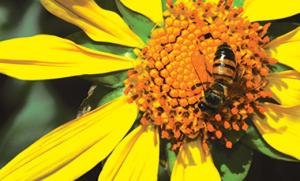
To celebrate National Plant a Flower Day, the New Jersey Plant Materials Center (NJPMC) is celebrated in the most appropriate way possible, by planting a little over an acre of flowers to create pollinator habitat.
By Scott Snell, Cape May Plant Materials Center Natural Resource Specialist
To celebrate National Plant a Flower Day, the New Jersey Plant Materials Center (NJPMC) is celebrating in the most appropriate way possible, by planting a little over an acre of flowers to create pollinator habitat. The project was initiated last year to convert a poorly performing field to a forage area for native pollinating insects to feed. The NJPMC staff hopes to achieve multiple goals as a result of their efforts with this project:
- To examine the success of a novel two-phase pollinator habitat establishment method
- To convert an underperforming production field to valuable habitat for native pollinating insects
- To create a teaching tool that can be used during outreach and technology transfer events offered by NRCS and partners
NJPMC staff collaborated with NJ Audubon and Xerces Society staff to create a site-appropriate native pollinator seed mix. Phase 1 of the seed mix was planted last May and included lanceleaf tickseed, black-eyed Susan, eastern purple coneflower, partridge pea, and shore little bluestem. Phase two will be planted this month and will be made up of foxglove beardtongue, common milkweed, New England aster, narrowleaf mountain mint, blue wild indigo, sweet-scented Joe Pye weed, and Monarch Germplasm seaside goldenrod. Once established, the variety of flowering plants should provide an abundant food source for native pollinating insects from spring through the fall while the native bunch grass (shore little bluestem) provides nesting habitat.
And you too can celebrate the day! Whether you go big and plant an acre of pollinator habitat or start small with a patio container garden is up to you. Some quick internet searches can introduce you to a plethora of DIY home gardening hacks in and around the home oftentimes reusing or repurposing materials that would otherwise end up in the trash. The key question is what to plant and the answer to that is it depends on where it will be planted.

Plan ahead and select appropriate plants for the intended site conditions. A few important aspects of the intended planting site to consider are:
- Climate – check the USDA Hardiness Zone Map
- Micro-climate
- Sun and shade exposure
- Soil moisture and drainage
- Exposure to salt – distance to heavily salted roads and the runoff from them
- Pool area – chlorine is toxic to plants
- Wildlife browsing pressure
When deciding what types of flowers to plant, we recommend planting native species or a locally sourced ecotype if possible. Why risk introducing a nonnative invasive plant when there are so many beautiful native plants to choose from? Consulting recommended plant lists from experts is a great way to choose which kinds of flowers you want to work with. The Xerces Society has partnered with native seed producers to make site and region-appropriate pollinator conservation seed mixes commercially available. The Mid-Atlantic Native Seed Mix is recommended for New Jersey.

And finally, remember to enjoy the process. Don’t focus solely on the end goal of a picturesque flower but appreciate the anticipation of that first sprout as it breaks through the surface due to the conditions you provided. Take note of the incremental changes your plants display as they mature; although they are so gradual your plant deceptively appears motionless, the day-to-day and week-to-week changes prove otherwise. And don’t be sad when the flowers eventually wither and fade; rather find joy in the fact that they have served their purpose. Then gather the seed produced thanks to your flowers and store it in preparation for the next National Plant a Flower Day!

